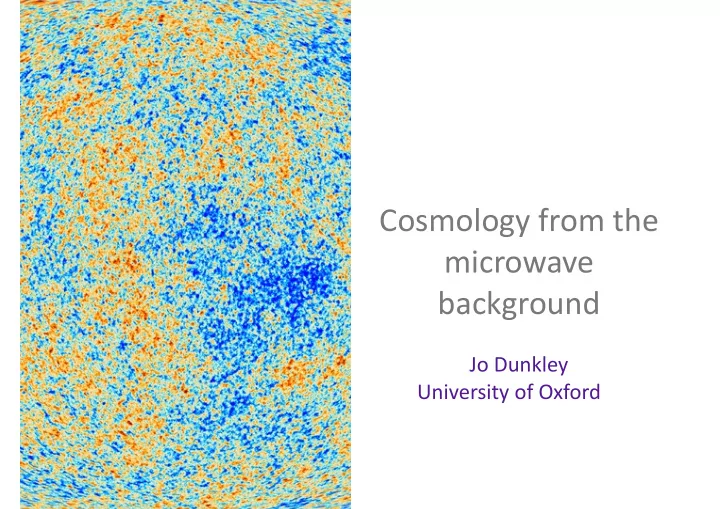

Cosmology(from(the( microwave( background( Jo(Dunkley( University(of(Oxford( Jo Dunkley
History of early universe Inflation? T ∼ 10 15 GeV t ∼ 10 -35 s CDM decoupling? T ∼ 10 GeV? t ∼ 10 -8 s Neutrino decoupling T ∼ 1 MeV t ∼ 1s Big Bang Nucleosynthesis T ∼ 100 keV t ∼ 10 min Matter-Radiation Equality T ∼ 0.8 eV t ∼ 60,000 yr Recombination T ∼ 0.3 eV t ∼ 380,000 yr Later: Neutrinos become ‘cold’ < t~100,000,000 yr
t z=1000, 380 000 yrs
Seeds of structure 1. Inflation (?) imprints quantum fluctuations. 2. Space expands, regions enter into causal contact and start to evolve. 3. Coupled baryons and photons produce oscillations in plasma. After 380,000 years the fluctuations have evolved, and we see a snapshot of them as anisotropies in CMB. Linearity means we can use the anisotropies to infer the initial fluctuations and the contents of the Universe.
Planck(Collaboration(2015
100 GHz 143 GHz 217 GHz Plus(6(other(wavelengths
A Q Stokes(vectors cmb A U cmb largest(scales(removed − 3 0 3 Planck(Collaboration(2015 µ K
Q E U B ACTPol maps, scale 15 uK, 10 degrees, Naess et al 2014
Lensing(potential,(phi φ WF (Data) ˆ Planck(Collaboration(2015 d ) = T ( n ) = T ( n + ∇ φ )
What(are(the(geometry,(contents,(and(initial(conditions( of(the(Universe?( What(happened(to(start(the(expansion?(Why?( What(are(the(properties(of(the(dark(sector?(
Rough(description(of(CMB(analysis(process:( ‘Data’(((((=(maps(of(the(blackbody(sky((temp,(pol,(lensing)( Statistic(=(angular(power(spectrum(of(maps( Output(((=(cosmological(parameters((reliable(codes( (((((((((((((((((((((((((((((predict(their(theory(power(spectra)
CMB(temperature Angular scale 90 � 18 � 1 � 0.2 � 0.1 � 0.07 � 0.05 � 10 4 Planck ACT SPT 10 3 D ` [ µ K 2 ] 10 2 10 1 Planck(Collaboration(2015 2 10 30 1000 2000 3000 4000 Multipole moment, ` 6Rparameter(LCDM(fits(extremely(well:(constraints(on(baryon,(CDM(and(Lambda(fractions,(and(size( of(initial(fluctuations.(Relic(DM(density( Ω c h 2 = 0.120 ± 0.003 (
CMB(polarization((ERmode) 100 Planck(Collaboration(2015 [10 − 5 µ K 2 ] 80 60 40 C EE 20 ` 0 -4 2000 30 500 1000 1500 2000 Greatly(limits(vast(zoo(of(alternatives(to(LCDM,(e.g.( • different(contents:( extra(relativistic(species,(early(dark(energy( • different(initial(fluctuations:( scale5dependent(power,(tensor(or(isocurvature(fluctuations ( • extra(components:( cosmic(defects,(magnetic(fields( • non5standard(BBN(or(recombination(history,(dark(matter(annihilation
Dark(Matter( annihilation 10 − 23 Planck TT,TE,EE+lowP WMAP9 CVL Possible interpretations for: 10 − 24 f e ff � σ v � [cm 3 s − 1 ] AMS-02/Fermi/Pamela Fermi GC 10 − 25 Thermal relic 10 − 26 10 − 27 1 10 100 1000 10000 m χ [GeV] dE dtdV ( z ) = 2 g ρ 2 crit c 2 Ω 2 c (1 + z ) 6 p ann ( z ) , (81) where p ann is defined as p ann ( z ) ⌘ f ( z ) h σ 3 i (82) , 16 m χ the critical density of the Universe today, m is the mass of
CMB(lensing 1.6 � / 2 � [ × 10 7 ] T only T + P 1.2 [ � ( � + 1)] 2 C �� 0.8 0.4 0.0 50 100 150 200 250 300 350 400 2 ] Planck(Collaboration(2015 Lensing(limits(curvature(to(2%,(and(neutrino(mass(sum(to(0.7(eV.
Neutrino(properties(from(cosmology Planck(Collaboration(2015 (1) Number(of(species:( 8 Planck TT+lowP 7 Planck TT+lowP+BAO Planck TT,TE,EE+lowP N e ff = 3 . 13 ± 0 . 32 Planck TT 6 N 3 15 0 23 Planck TT 5 N e ff (2) Neutrino(mass 4 A v e r e t a l . ( 2 0 1 3 ) 3 X Planck TT m ν < 0 . 68 eV 2 ) 4 1 0 Planck TT 2 ( . l a t e e k o 1 o C X +(BAO Planck TT m ν < 0 . 23 eV 0 0.018 0.020 0.022 0.024 0.026 Planck TT 2 ω b More species: longer radiation domination, suppress acoustic oscillations, anisotropic stress shifts peaks More mass: neutrinos switch from being relativistic (hot) to non-relativistic (cold) earlier. Hot neutrinos free-stream, reducing matter clustering and damping of photon-baryon oscillations compared to CDM.
In(next(decade:(measure(neutrino(mass? From(oscillation(expt,(minimum( mass(sum(=(60(meV.( Forecasted(errors:( 2015(((Planck(((+(BOSS(((((100(meV( 2017(((ACTPol((+(BOSS((((((60( 2019(((AdvACT(+(BOSS((((((40( 2021(((AdvACT(+(DESI(((((((20( 2020s(CMBRS4(+(DESI(((((((16 Aberzajian(et(al(2014
Inflation(status(from(Planck Universe(is(flat(to(0.5%,(fluctuations(are(super5horizon,(Gaussian(and(adiabatic Planck Collaboration: Cosmological n s = 0.96 1500 n s = 1.00 � 2 D � [mK 2 ] 1000 500 n<1 0 100 500 1000 2000 Multipole moment � Planck(Collaboration(2014,(2015(
Gravitational(waves From(K(Story k + 2 ˙ a ˙ ˙ ˙ k − k 2 h k = 0 h h a T 0
Gravitational(waves From(K(Story k + 2 ˙ a ˙ ˙ ˙ k − k 2 h k = 0 h h a T 0
New(limits(on(tensor(modes BRmode(power BKxBK 0.05 (BKxBK − α BKxP)/(1 − α ) 0.04 0.03 0.02 0.25 Planck TT+lowP 0.01 Planck TT+lowP+BKP N +lensing+ext = 0 N 6 = 0 0.20 5 0 − 0.01 0 50 100 150 200 250 300 Multipole φ 2 0.15 Planck/BICEP2(Collaborations(2015 r 0.002 Convex Concave 0.10 φ 0.05 0.00 0.95 0.96 0.97 0.98 0.99 1.00 Planck(Collaboration(2015 n s
Planck(gave(us(new(view(of(the(Galaxy 30 44 70 100 143 217 353 Synchrotron RMS brightness temperature ( µ K) 2 10 Until(Planck,(dust(level( uncertain(to( order%of% Thermal dust magnitude% 1 10 Sum fg 0 10 CMB A P d -1 10 10 30 100 300 1000 Frequency (GHz) Planck(Collaboration(2015 (level(over(70R90%(of(sky) 0 20 200 µ K RJ @ 353 GHz
Path(ahead Now:(’StageR3’(CMB:(Spider,(PolarBear,(BICEP3,(Keck,(CLASS,(SPTR3G,(GroundBird( My(project((led(in(Princeton):(AdvACT(( Targeting(r=0.01(with( five (wavelengths(2016R18. Next:(CMBRS4(campaign(from(~2020R25(
Cosmic(microwave(background(data(continue(to(demand( LCDM(cosmological(model.(It(holds(up(very(well(to(new(lensing( and(polarization(measurements(from(the(Planck(satellite.( • If(inflation(is(not(correct(scenario,(it(has(to(look(a(lot(like( it.(Gravitational(wave(search(still(firmly(on.( • Neutrino(sector(holds(questions(that(cosmology(can(help( answer(in(coming(decade.(
Recommend
More recommend